
Every person is unique!
Our experienced team will be happy to advise you in detail and free of charge on all matters relating to your health. Book your consultation appointment now:
Gastrointestinal disorders: Vital mushrooms as a natural remedy against heartburn, bloating, diarrhea and Co.
January 16, 2021
Dipl.-Bio. Dorothee Ogroske et al.
Our digestive tract is a very complex system. He has many tasks to manage and is accordingly easy to get out of balance. This is all the more fatal because our entire health depends on its functioning. The good news is that you can support your stomach and intestines very well with vital mushrooms. Medicinal mushrooms have a preventive effect, but have also proven their worth in the treatment of various gastrointestinal diseases.
What symptoms indicate gastrointestinal disease?
Have you noticed any changes in your digestion lately? Do you perhaps suffer from gas or bloating more often? What symptoms are actually indications of gastrointestinal disease? This question is not easy to answer. The human digestive tract is a complex system and is related to many organs and even the brain. So if you suffer from symptoms such as diarrhea, constipation, blood in the stool, abdominal pain, heartburn, as well as fatigue, depressed mood and exhaustion, you should take a close look at your gastrointestinal tract.
From the plate to the stomach
 If you bring the fork to your mouth, the first digestive process takes place there. Use your teeth to crush the food and mix it with saliva to form a porridge. The digestion of complex carbohydrates already begins in the mouth. We can notice this by the fact that if we chew a piece of bread long enough, a sweet taste is created by the resulting cleavage product, glucose. From the mouth, the food pulp passes through the esophagus into the stomach. The transition to the stomach is controlled by the so-called esophageal sphincter, a ring muscle. It ensures that predigested stomach contents cannot get back into the esophagus.
From the stomach, the digestive processes become complex. In the following, we will explain the individual stages of digestion in more detail.
If you bring the fork to your mouth, the first digestive process takes place there. Use your teeth to crush the food and mix it with saliva to form a porridge. The digestion of complex carbohydrates already begins in the mouth. We can notice this by the fact that if we chew a piece of bread long enough, a sweet taste is created by the resulting cleavage product, glucose. From the mouth, the food pulp passes through the esophagus into the stomach. The transition to the stomach is controlled by the so-called esophageal sphincter, a ring muscle. It ensures that predigested stomach contents cannot get back into the esophagus.
From the stomach, the digestive processes become complex. In the following, we will explain the individual stages of digestion in more detail. The stomach
The stomach muscles ensure optimal mixing of the food pulp with the digestive juices released. Important for the digestive process is first the production and secretion of gastric acid. The vestibular cells in the stomach wall are responsible for this. 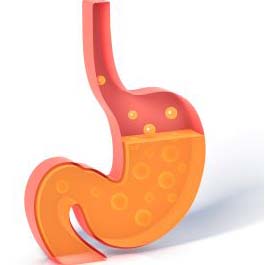 Stomach acid is hydrochloric acid, which has a very low pH value. In this very acidic environment, the proteins ingested with food are prepared for digestion, they are denatured. For protein digestion, the principal cells release precursors of protein-cleaving enzymes, pepsinogen, into the stomach contents. Hydrochloric acid activates pepsinogen to the active enzyme pepsin. This immediately begins to break down proteins in the food. In principle, pepsin would not stop at the stomach wall. However, a protective coating of mucus on the inner wall prevents the stomach from digesting itself in this way. This protective mucus is formed by the accessory cells of the stomach. However, the task of gastric acid is also to kill germs that enter the stomach with the food and to transport them further with the help of the mucus and ultimately to excrete them with the stool.
Stomach acid is hydrochloric acid, which has a very low pH value. In this very acidic environment, the proteins ingested with food are prepared for digestion, they are denatured. For protein digestion, the principal cells release precursors of protein-cleaving enzymes, pepsinogen, into the stomach contents. Hydrochloric acid activates pepsinogen to the active enzyme pepsin. This immediately begins to break down proteins in the food. In principle, pepsin would not stop at the stomach wall. However, a protective coating of mucus on the inner wall prevents the stomach from digesting itself in this way. This protective mucus is formed by the accessory cells of the stomach. However, the task of gastric acid is also to kill germs that enter the stomach with the food and to transport them further with the help of the mucus and ultimately to excrete them with the stool.
The vestibular cells produce not only hydrochloric acid, but also basic sodium bicarbonate at the same time. Acid and base production are therefore directly related to each other. However, sodium bicarbonate is passed through the bloodstream to basophilic organs such as the liver, pancreas, and gastric mucus-forming accessory cells.
EXPERIENCE REPORTS
"My nervous stomach and intestinal problems tormented me. I always had diarrhea after eating. With the medicinal mushrooms my problems have gradually improved and now after two years the diarrhea is even completely gone."
EXPERIENCE REPORTS
"I suffered from prolonged diarrhea as well as watery stools with mucus for months. The previous treatment with antibiotics, cortisone, etc. did not help me at all. Shortly after I started taking the medicinal mushroom Hericium, my condition improved and now I am doing very well."
The intestine
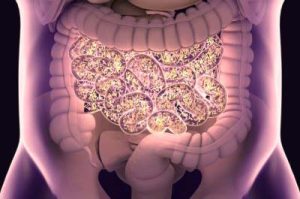 The intestine is not only the central place of digestion, it is also an important pillar of our health. Thus, it is closely related to the immune system and psyche. This means that a susceptibility to infections or depression may be partly caused by a disturbance of the intestinal environment. Unfortunately, initial symptoms of a disorder or disease are often difficult to assign. Fortunately, vital mushrooms and other natural remedies help against heartburn, constipation, flatulence, abdominal pain as well as other dysfunction without producing side effects.
The intestine is not only the central place of digestion, it is also an important pillar of our health. Thus, it is closely related to the immune system and psyche. This means that a susceptibility to infections or depression may be partly caused by a disturbance of the intestinal environment. Unfortunately, initial symptoms of a disorder or disease are often difficult to assign. Fortunately, vital mushrooms and other natural remedies help against heartburn, constipation, flatulence, abdominal pain as well as other dysfunction without producing side effects.

Every person is unique!
Our experienced team will be happy to advise you in detail and free of charge on all matters relating to your health.
Small and large intestine
Anatomists divide the intestine into two major sections: the small intestine and the large intestine. The names refer to the diameter of these intestinal segments. While the small intestine connects directly to the stomach and reaches up to five meters in length, the large intestine forms the last part of the intestine.
The small intestine consists of the twelve-finger, empty, and ileum. The main task of the small intestine is to break down food into smaller and smaller components, which are ultimately absorbed by the mucosa of the small intestine. From there, the nutrients enter the blood. Because the process of thorough dissection takes a long time, the small intestine is so long. Various digestive juices such as saliva, gastric juice, bile, pancreatic and small intestinal secretions are involved in the digestive process. For a larger absorption surface, the inner wall of the small intestine is dotted with folds and protrusions, resulting in a total of about 200 square meters of mucosal surface. Vital mushrooms are a great way to care for this delicate mucosa.
The colon reaches a length of about one and a half meters. It begins with the appendix, where the appendix called “vermiform appendix” is located. This is followed by the ascending, transverse and descending branches of the colon. This is followed by an S-shaped bend called Sigma. The rectum forms the last section and finally opens into the anus. The main task of the colon is to thicken the stool. For this purpose, the mucosa absorbs water as well as electrolytes dissolved in it. The stool eventually collects in the rectum until the excretory reflex is triggered.
The twelve-finger intestine
The twelve-fingered intestine is an important section of the small intestine and has a lot of work to do.
When the acidic food pulp from the stomach reaches the twelve-finger intestine, it is essential to raise its pH. This occurs primarily through the very alkaline digestive juice of the pancreas and additionally through the bile juices produced in the liver. 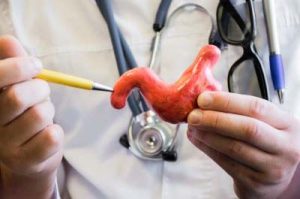 The secretion of the pancreas contains bicarbonate: it neutralizes the food pulp that has been acidified in the stomach, because otherwise the enzymes in the small intestine could not work. These enzymes are also supplied by the pancreas. They are amylases for carbohydrate digestion, proteases for protein breakdown, and lipases for fat cleavage. They enter the small intestine as inactive precursors and are only activated there. Before the lipases can do their work, the dietary fats must first be finely dispersed as fat droplets in the aqueous environment of the small intestine. The bile acids contained in the bile juice emulsify the fats, making cleavage by the pancreatic lipases possible in the first place.
The secretion of the pancreas contains bicarbonate: it neutralizes the food pulp that has been acidified in the stomach, because otherwise the enzymes in the small intestine could not work. These enzymes are also supplied by the pancreas. They are amylases for carbohydrate digestion, proteases for protein breakdown, and lipases for fat cleavage. They enter the small intestine as inactive precursors and are only activated there. Before the lipases can do their work, the dietary fats must first be finely dispersed as fat droplets in the aqueous environment of the small intestine. The bile acids contained in the bile juice emulsify the fats, making cleavage by the pancreatic lipases possible in the first place.
The intestinal mucosa
The mucous membrane in the small and large intestine is essential for functioning digestion. It ensures that only the required nutrients and water enter the body. It keeps all other substances and also pathogens from entering. The mucosa itself consists of mucosal cells that are connected to each other by ribbon-like proteins (tight junctions). Without these compounds, undigested substances and pathogens can slip between mucosal cells.
Headquarters of the immune system
Our defenses are directly related to our gut health because the gut is home to about 80% of our immune system, called the gut-associated immune system. Similarly, all mucous membranes in the body depend on the health of the intestinal mucosa. This is because the so-called “mucosal road” connects all mucous membranes with each other. That is why, for example, an infection of the mucous membrane in the nose and throat area is easier to treat if intestinal health is promoted at the same time.
The intestinal environment
The environment of our digestive tract is largely determined by a large number of bacteria that colonize the gastrointestinal tract. One also speaks of the physiological intestinal flora or de microbiota. They live in a symbiosis, i.e. a symbiotic community with our organism. Experts speak of around 160 different species of bacteria. Significantly more bacteria live in the large intestine than in the small intestine. In addition to digestion and the synthesis of vitamins and amino acids, their role is to defend against pathogens. In addition, the bacteria strengthen the immune system through continuous training. They nourish the intestinal mucosa by supplying it with short-chain fatty acids. If the intestinal environment is out of balance, the door is wide open to various health problems such as irritable bowel syndrome, metabolic syndrome, diabetes, chronic inflammatory bowel diseases, rheumatoid arthritis and also cardiovascular diseases and neurological disorders. Prebiotics support the intestinal flora. For example, the long-chain carbohydrates (polysaccharides) from vital mushrooms have a prebiotic effect.
The gut-brain axis
The intestine and brain are in constant exchange with each other. For example, the intestine is surrounded by a good 100 million nerve cells. Close contact between the brain and the intestine is important, among other things, for a balance between supplied and required nutrients. Ideally, this gives us an appetite for the very things that contain the nutrients we lack. 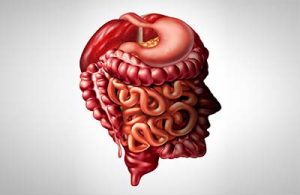 Furthermore, it is necessary to regulate the various circuits involved in the transport of the food pulp. To do this, the brain must maintain the balance between inhibitory (serotonin) and excitatory nerve messengers (norepinephrine). 95% of serotonin is formed in the intestine itself. This “happiness hormone” has a mood-lifting, relaxing and appetite-regulating effect. Directly in the intestine, it regulates secretion and absorption processes. In addition, it determines the perception of pain here. People with irritable bowel syndrome often have low serotonin levels.
Furthermore, it is necessary to regulate the various circuits involved in the transport of the food pulp. To do this, the brain must maintain the balance between inhibitory (serotonin) and excitatory nerve messengers (norepinephrine). 95% of serotonin is formed in the intestine itself. This “happiness hormone” has a mood-lifting, relaxing and appetite-regulating effect. Directly in the intestine, it regulates secretion and absorption processes. In addition, it determines the perception of pain here. People with irritable bowel syndrome often have low serotonin levels.
Due to the close cooperation of the intestine with the nervous system, it reacts particularly sensitively to stress: An overactivity of the sympathetic system or also a dysfunction of the parasympathetic system have a direct effect on digestion. Symptoms may include “stomach rumbling,” sudden urgent bowel movements, or diarrhea. In the longer term, diseases such as irritable bowel or stomach may develop. This is where vital mushrooms come in. On the one hand, they have a calming and balancing effect on the nervous system, and on the other hand, they improve digestion and the intestinal environment.
What are the gastrointestinal diseases?
As you have now seen, our digestive system is complex and closely connected to other areas of the body. Unfortunately, the complexity also brings with it a multitude of possibilities for falling ill. Here we present an overview of the most common gastrointestinal diseases and their causes.
The leaky gut syndrome
The English expression “Leaky Gut” means something like “leaky gut”. In this disease, the intestinal mucosa has small holes, so that the natural barrier is no longer guaranteed. This problem occurs mainly in the area of the small intestine, where incompletely digested food components, allergens and toxins, among other things, can then enter the body directly. With the weakened barrier and defective tight junctions come a thin mucus layer, low sIgA levels, and disturbed intestinal flora. Inflammation occurs, which further promotes leakage. Now the immune system kicks in and takes action against the unwanted intruders. This is often the beginning of food allergies. Sometimes the substances that enter the organism resemble the body’s own tissue structures. As a result, the immune system attacks corresponding tissues. This is how autoimmune diseases occur.
The causes of leaky gut are manifold and not conclusively clarified. It is probably always an interaction of various unfavorable factors such as:
- poor diet with lots of simple carbohydrates, little fiber, and lots of bad fats and alcohol
- Medications, e.g. antibiotics, non-steroidal anti-inflammatory drugs, cortisone
- Radiation and chemotherapy
- Candida infestation
- prolonged stress
- Vital substance deficiency, especially vitamin A and zinc
- Gastrointestinal tract infections
- Food intolerances
Leaky gut syndrome is often the undetected cause of other diseases, some of which are considered incurable. The connection with a disturbance of the intestinal function is often not obvious:
- Allergies, food intolerances
- Asthma
- Autoimmune diseases
- Neurodermatitis and other skin diseases
- Cardiovascular diseases
- Multiple sclerosis
- Ankylosing spondylitis
- Chronic fatigue syndrome
- Migraine/Headache
The good news is that leaky gut can be treated well with natural remedies like medicinal mushrooms. Thus, improvement of the secondary disease is also likely.
Irritable Stomach
Irritable stomach is a diagnosis of exclusion. This means that this diagnosis is made when all other possible causes have been ruled out. Complaints include a feeling of fullness and even pressure in the upper abdomen, belching, nausea and vomiting with vegetative symptoms such as palpitations and heavy sweating. 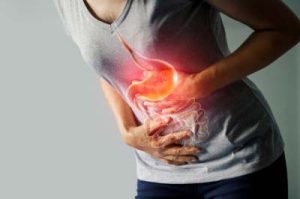 The exact cause is unclear. Experts assume a hypersensitivity of the affected persons. Examinations also often reveal psychological distress in patients as well as a history of other gastrointestinal disease. An unhealthy lifestyle as well as poor nutrition aggravate the problem.
The exact cause is unclear. Experts assume a hypersensitivity of the affected persons. Examinations also often reveal psychological distress in patients as well as a history of other gastrointestinal disease. An unhealthy lifestyle as well as poor nutrition aggravate the problem.
Irritable bowel
Irritable bowel often occurs together with irritable stomach. The physician also makes this diagnosis when other clinical pictures can be ruled out. Indications of irritable bowel syndrome may include prolonged abdominal pain with bloating, constipation or diarrhea. Persistent fatigue and negative mood also occur in this context.
Gastritis
Chronic inflammatory bowel disease
Other diseases of the digestive tract
In addition to the diseases already explained, tumors may form in the digestive tract. While colorectal cancer usually arises from polyps, gastric cancer often develops in connection with an infection with Helicobacter pylori. These bacteria are also consistently associated with ulcers in the stomach and twelve-finger intestine.
Doctors speak of diverticulosis when the intestinal wall bulges outward through the intestinal muscles. Stool can be deposited in these protrusions. If inflammation then occurs, the disease is called diverticulitis. It occurs most frequently in the sigma. Symptoms may include fever or cramps in addition to constipation, diarrhea and pain in the left lower abdomen.
Food intolerances or intolerances are usually based on a defective mucosal barrier in the intestine. This is accompanied on the one hand by a lack of enzymes for the breakdown of carbohydrates such as lactose or fructose. On the other hand, a sensitization of the gut-associated immune system with regard to certain food allergens subsequently takes place. The complaints are varied and individual.
Small Intestinal Bacterial Overgrowth” (SIBO) is characterized by an abnormal colonization of the small intestine with microorganisms. This manifests itself in a sensitivity to certain foods, especially those high in fiber. The symptoms are very diverse, including increased flatulence, bloating, diarrhea or constipation.
Doctors speak of reflux when stomach contents or stomach acid flows in the direction of the esophagus. Over time, the acidic pulp damages the mucosa of the esophagus, causing heartburn. This is not infrequently caused by fermentation processes in the stomach resulting from restricted digestive secretion. Complaints such as heartburn and reflux do not necessarily have to be caused by “too much” stomach acid. Problems on an emotional level – “something pisses us off” can additionally contribute to this. This must be solved. However, there are also one or two natural remedies for heartburn that provide relief.
Effect of vital mushrooms in gastrointestinal diseases
- Reduce stress
- soothe the mucous membrane
- support the development of the mucosal barrier
- soothe inflammation
- have anti-allergic, antiviral, antibacterial, antifungal effect
- have a prebiotic effect
- have a laxative, regulating, constipating effect on the intestine
- activate the immune system
- reduce the risk of ulcers and tumors
Vital mushroom Hericium
Hericium is the vital mushroom of choice when it comes to gastrointestinal complaints. The reason for this is its many positive influences on the digestive tract. That’s how it works …
- regenerating on gastric and intestinal mucosa: It supports their structure with its beta-glucans.
- anti-inflammatory: especially in combination with the medicinal mushroom Reishi, it provides relief from chronic inflammatory bowel diseases and other inflammations of the mucous membranes
- prebiotic: it specifically promotes eubiosis in the intestine, which means that it reduces pathogenic germs and favors the growth of physiological intestinal flora. such bacteria produce the short-chain fatty acids such as the butyric or lactic acid, which strengthen the intestinal environment
- antibacterial: Hericium fights Helicobacter pylori.
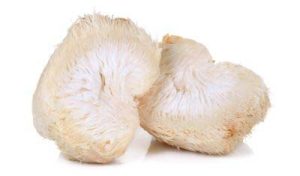 For all these reasons, Hericium is a proven natural remedy for heartburn, reflux, gastritis and stomach ulcers. If it is used against chronic inflammatory bowel diseases, continuous intake is recommended even during symptom-free phases. Hericium also contains erinacins, which stimulate nerve growth factor (NGF). As a result, stress symptoms such as restlessness, anxiety and sleep disorders decrease. This makes it a helpful natural remedy for irritable stomach, irritable bowel and similar nervous complaints.
For all these reasons, Hericium is a proven natural remedy for heartburn, reflux, gastritis and stomach ulcers. If it is used against chronic inflammatory bowel diseases, continuous intake is recommended even during symptom-free phases. Hericium also contains erinacins, which stimulate nerve growth factor (NGF). As a result, stress symptoms such as restlessness, anxiety and sleep disorders decrease. This makes it a helpful natural remedy for irritable stomach, irritable bowel and similar nervous complaints.
Finally, Hericium has also proven its value in the adjunctive treatment of cancer of the gastrointestinal tract.
Vital mushroom Reishi
Very often Hericium is administered in combination with Reishi for gastrointestinal disorders. The two complement and support each other very well in their mode of action. In this regard, reishi has the following health-promoting properties:
- Anti-allergic: This effect is also due to the triterpenes. They inhibit the release of histamine, which is often increased during stress and inflammation. Histamine in turn promotes allergic reactions, which can also affect the digestive tract.
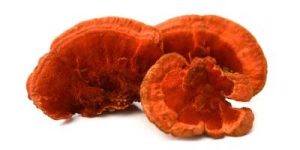
- anti-inflammatory: Finally, triterpenes are also believed to have anti-inflammatory properties. This makes Reishi an effective natural remedy for heartburn, gastritis and diverticulitis.
- Antioxidant: The antioxidants in reishi bind free radicals that are produced by inflammation and infections. Consequential damage is thus prevented.
- immunomodulating: especially the beta-glucans of the reishi strengthen the immune system, but also prevent excessive reactions.
- detoxifying, liver activating: the liver can be very stressed by the influx of intestinal toxins through the blood. The Reishi supports the liver in its function as the main metabolic organ and helps to bring the toxins better to the excretion
- Relaxing: The adenosine from reishi directly counteracts the neurotransmitter acetylcholine. It inhibits the transmission of the stimulus from the nerve to the muscle, which brings a relaxed musculature. This effect is noticeable on a psychological level, which means that you feel calmer after taking Reishi. The vegetative balance in turn directly counteracts irritable stomach and intestines.
Finally, the ingredients of the reishi promote the healing process of the gastric mucosa, for example, after a stomach ulcer. They also have a prebiotic effect and inhibit the spread of fattening bacteria.
Vital mushroom Cordyceps
 In addition to its anti-inflammatory effects, the greatest importance of cordyceps with regard to diseases of the gastrointestinal tract is its potential to relieve stress. On the one hand, this occurs via the regulation of hormone production in the adrenal cortex. On the other hand, the amino acid L-tryptophan from cordyceps stimulates serotonin synthesis. Therefore, people feel more balanced and satisfied when taking this vital mushroom regularly. Stress-related symptoms of the stomach and intestines become less likely.
In addition to its anti-inflammatory effects, the greatest importance of cordyceps with regard to diseases of the gastrointestinal tract is its potential to relieve stress. On the one hand, this occurs via the regulation of hormone production in the adrenal cortex. On the other hand, the amino acid L-tryptophan from cordyceps stimulates serotonin synthesis. Therefore, people feel more balanced and satisfied when taking this vital mushroom regularly. Stress-related symptoms of the stomach and intestines become less likely.
Vital mushroom Pleurotus
The pleurotus has a prebiotic effect. In particular, it supports the proliferation of lactobacilli, enterococci and bifidobacteria. A healthy intestinal environment automatically strengthens the body’s defenses. In addition, the pleurotus has anti-allergic and cholesterol-lowering effects. Both reduce the load on the gastrointestinal tract.
Vital mushroom Coprinus
Coprinus is believed to have mainly digestive properties. Thus, it can help with constipation, and prevents the formation of hemorrhoids. Its ingredients stabilize blood sugar levels, which can prevent cravings.
Vital mushroom Coriolus
As a pillar of the immune system, coriolus activates the TH1 immune response. This is used for the targeted defense against bacteria, viruses and fungi. Typical troublemakers in the gastrointestinal tract are Candida and Helicobacter pylori. 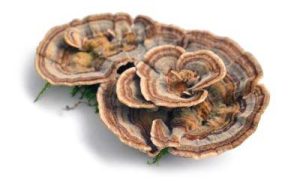 Thanks to its antioxidant properties, it curbs the negative effects of inflammation and infection. In addition, its use has been proven in gastrointestinal tumors and SIBO.
Thanks to its antioxidant properties, it curbs the negative effects of inflammation and infection. In addition, its use has been proven in gastrointestinal tumors and SIBO.
Vital mushroom Maitake
Alternative medicine practitioners prefer to use maitake for diarrhea. Here, the combination with the Reishi has proven successful. Since maitake also has anti-inflammatory ingredients, it is an ideal medicinal mushroom for chronic inflammatory bowel diseases. Their treatment is also served by its prebiotic properties. By reducing the storage of triglycerides in the liver, it prevents fatty liver. Studies have shown that its use also reduces the risk of polyps and cancer in the digestive tract. In practice, it has proven effective in cases of bloating and flatulence.
Vital mushroom Auricularia
This vital mushroom is known for its ability to moisturize the mucous membranes. On the one hand, this promotes their natural protective barrier and, on the other hand, helps against constipation, which according to TCM stems from dryness. Affected people are recommended to drink a lot of liquids parallel to taking Auricularia, as well as to consume a lot of fiber. Finally, the adenosine contained in Auricularia improves general blood circulation in the body, which of course also benefits the digestive tract and its mucous membranes.
Vital mushroom Chaga
In Russia, Finland and China, Chaga is the classic medicinal mushroom for the treatment of gastrointestinal disorders. It works
- antibacterial
- anti-inflammatory
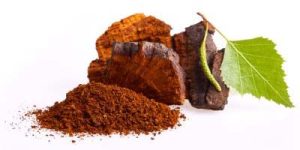
- antioxidant
- antitumoral
- prebiotic
From these properties follows a general strengthening of the digestive tract, minimizing in particular the risk of inflammation and ulcers. Similarly, under the intake of Chaga, the formation of tumors and metastases is less likely. Its anti-inflammatory action makes it a popular medicinal mushroom for complaints typical of gastritis.
Vital mushroom shiitake
Shiitake contains a very special polysaccharide: lentinan. Many studies show that the mushroom strengthens the body’s defenses through this and other contained beta-glucans. It promotes the production of secretory immunoglobulin A (sIgA). With the help of this mucosa-protecting antibody, shiitake protects all mucous membranes in the body from attack by viruses and bacteria. In addition, studies showed an improvement in intestinal flora after prolonged intake of shiitake powder.
Tips for taking vital mushrooms
We recommend that you always use powder from the whole mushroom. Only in this way can you be sure of all the valuable ingredients. A cultivation according to organic guidelines as well as a gentle drying process are the basis of a high-quality product. Although there are no side effects in the actual sense in connection with vital mushrooms, a gradual dosage is advisable. The digestive tract can thus slowly get used to the fiber contained in the mushroom powder. A general dosage cannot be determined. The vital mushroom variety and dose must be elicited depending on the person and complaints. For this, feel free to contact our experts, who draw on their many years of experience and expertise.
DO YOU HAVE ANY QUESTIONS?
We will gladly take time for you. In our free consultation, we answer all your health questions individually and personally. We are looking forward to meeting you!
